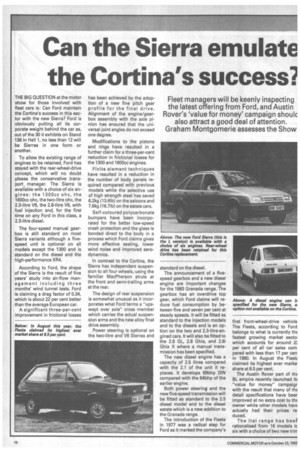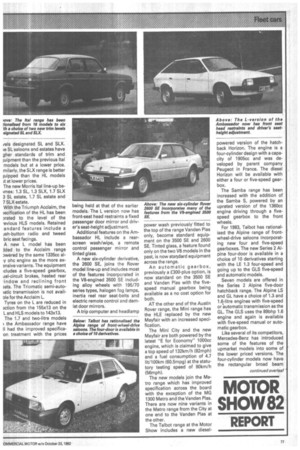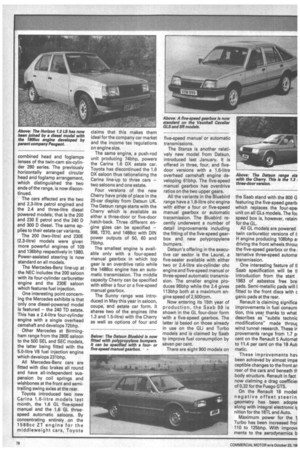Can the Sierra emulate the Cortina's success?
Page 48

Page 49

Page 50

Page 51

If you've noticed an error in this article please click here to report it so we can fix it.
Fleet managers will be keenly inspecting the latest offering from Ford, and Austin Rover's 'value for money' campaign shoulc also attract a good deal of attention. Graham Montgomerie assesses the Show
THE BIG QUESTION at the motor show for those involved with fleet cars is: Can Ford maintain the Cortina's success in this sector with the new Sierra? Ford is obviously putting all its corporate weight behind the car as, out of the 30 it exhibits on Stand 136 in Hall 1, no less than 12 will be Sierras in one form or another.
To allow the existing range of engines to be retained, Ford has stayed with the rear-wheel-drive concept, which will no doubt please the conservative transport, manager. The Sierra is available with a choice of six engines: the 1 3 00cc ohc, the 1600cc ohc, the two-litre ohc, the 2.3-litre V6, the 2.8-litre V6, with fuel injection and, for the first time on any Ford in this class, a 2.3-litre diesel.
The four-speed manual gearbox is still standard on most Sierra variants although a fivespeed unit is optional on all models except the 1300 and is standard on the diesel and the high-performance XR4.
According to Ford, the shape of the Sierra is the result of five years' study into air-flow management including three months' wind tunnel tests. Ford is claiming a drag factor of 0.34, which is about 22 per cent better than the average European car.
A significant three-per-cent improvement in frictional losses has been achieved by the adoption of a new fine pitch gear profile for the final drive. Alignment of the engine/gearbox assembly with the axle pinion has ensured that the universal joint angles do not exceed one degree.
Modifications to the pistons and rings have resulted in a further claim for a three-per-cent reduction in frictional losses for the 1300 and 1600cc engines.
Finite element techniques have resulted in a reduction in the number of body panels required compared with previous models while the selective use of high strength steel has saved 6.2kg (13.61b) on the saloons and 7.6kg (16.71 b) on the estate cars.
Self-coloured polycarbonate bumpers have been incorporated for the better low-speed crash protection and the glass is bonded direct to the body in a process which Ford claims gives more effective sealing, lower wind noise and improved aerodynamics.
In contrast to the Cortina, the Sierra has independent suspension to all four wheels, using the familiar MacPherson struts at the front and semi-trailing arms at the rear.
The design of rear suspension is somewhat unusual as it incorporates what Ford terms a "upswept over axle" cross member which carries the actual suspension arms and the new alloy final drive assembly.
Power steering is optional on the two-litre and V6 Sierras and standard on the diesel.
The announcement of a fivespeed gearbox and a new diesel engine are important changes for the 1983 Granada range. The gearbox has an overdrive top gear, which Ford claims will reduce fuel consumption by between five and seven per cent at steady speeds. It will be fitted as standard to the injection models and to the diesels and is an option on the two and 2.3-I itre-engined cars. It will also be fitted to the 2.8 GL, 2.8 Ghia, and 2.8i Ghia X where a manual transmission has been specified.
The new diesel engine has a capacity of 2.5 litres compared with the 2.1 of the unit it replaces. It develops 69bhp DIN compared with the 64bhp of the earlier engine.
Both power steering and the new five-speed transmission will be fitted as standard to the 2.5 diesel model and to the diesel estate which is a new addition to the Granada range.
The introduction of the Fiesta in 1977 was a radical step for Ford as it marked the company's first front-wheel-drive vehicle The Fiesta, according to Ford belongs to what is currently the fastest growing market sectoi which accounts for around 2:: per cent of all car sales corn. pared with less than 17 per ceni in 1980. In August the Fieste claimed its highest ever markei share at 8.5 per cent.
The Austin Rover part of thE BL empire recently launched itE "value for money" campaigr with the result that many of thE detail specifications have beer improved at no extra cost to thE owner while other models havE actually had their prices re. duced.
The ltal range has beet rationalised from 16 models tc six with a choice of two new trirr /els designated SL and SLX. ie SL saloons and estates have gher standards of trim and luipment than the previous Rai models but at a lower price. milarly, the SLX range is better iuipped than the HL models it at lower prices.
The new Morris Itat line-up beImes: 1.3 SL, 1.3 SLX, 1.7 SLX 3 SL estate, 1.7 SL estate and 7 SLX estate.
With the Triumph Acclaim, the iecification of the HL has been prated to the level of the -evious HLS models. Retained :andard features include a Jsh-button radio and tweed bric seat facings.
A new L model has been Med to the Acclaim range Dwered by the same 1335cc alohc engine as the more exansive variants. The equipment 'dudes a five-speed gearbox, ual-circuit brakes, heated rear indow and reclining front ats. The Triomatic semi-autoiatic transmission is not availble for the Acclaim L.
Tyres on the L are reduced in action from the 155x13 on the L and HLS models to 143x13. The 1.7 and two-litre models the Ambassador range have II had the improved specificaon treatment with the prices being held at that of the earlier models. The L version now has front-seat head restraints a fixed passenger door mirror and driver's seat-height adjustment.
Additional features on the Ambassador HL include a rearscreen wash/wipe, a remote control passenger mirror and tinted glass.
A new six-cylinder derivative, the 2600 SE, joins the Rover model line-up and includes most of the features incorporated in the V8-engined 3500 SE including alloy wheels with 195/70 series types, halogen fog lamps, inertia reel rear seat-belts and electric remote control and demist door mirrors.
A trip computer and headlamp power wash previously fitted to the top of the range Vanden Plas only, become standard equipment on the 3500 SE and 2600 SE. Tinted glass, a feature found only on the two V8 models in the past, is now standard equipment across the range.
An automatic gearbox, previously a £300-plus option, is now standard on the 3500 SE and Vanden Plas with the fivespeed manual gearbox being available as a no cost option for both.
AT the other end of the Austin Rover range, the Mini range has the HLE replaced by the new Mayfair with an increased specification.
The Mini City and the new Mayfair are both powered by the latest "E for Economy" 1000cc engine, which is claimed to give a top speed of 132km/h (82mph) and a fuel consumption of 4.7 lit/100km (60.5mpg) at the statutory testing speed of 90km/h (56mph).
The new models join the Metro range which has improved specification across the board with the exception of the MG 1300 Metro and the Vanden Plas. There are now nine variants in the Metro range from the City at one end to the Vanden Plas at the other.
The Talbot range at the Motor Show includes a new diesel powered version of the hatchback Horizon. The engine is a four-cylinder design with a capacity of 1905cc and was developed by parent company Peugeot in France. The diesel Horizon will be available with either a four or five-speed gearbox.
The Samba range has been increased with the addition of the Samba S. powered by an uprated version of the 1360cc engine driving through a fivespeed gearbox to the front wheels.
For 1983, Talbot has rationalised the Alpine range of frontwheel-drive saloons incorporating new four and five-speed gearboxes. The new Series 2 Alpine four-door is available in a choice of 10 derivatives starting with the LE 1.3 four-speed and going up to the GLS five-speed and automatic models.
Seven models are offered in the Series 2 Alpine five-door hatchback range. The Alpine LS and GL have a choice of 1.3 and 1.6-litre engines with five-speed or automatic transmission as the GL. The GLS uses the 89bhp 1.6 engine and again is available with five-speed manual or automatic gearbox.
Like several of its competitors, Mercedes-Benz has introduced some of the features of the upmarket models into some of the lower priced versions. The four-cylinder models now have the rectangular broad beam combined head and foglamps lenses of the twin-cam six-cylinder 280 series. The previously horizontally arranged circular head and foglamp arrangement, which distinguished the two ends of the range, is now discontinued.
The cars affected are the two and 2.3-litre petrol engined and the 2.4 and three-litre diesel powered models; that is the 200 and 230 E petrol and the 240 D and 300 D diesel. The same applies to their estate car variants.
The 200 (two-litre) and 230E (2.3-litre) models were given more powerful engines of 109 and 136bhp respectively in 1980. Power-assisted steering is now standard on all models.
The MerOedes-Benz line-up at the NEC includes the 200 saloon with its four-cylinder carburetter engine and the 230E saloon which features fuel injection.
One interesting point concerning the Mercedes exhibits is that only one diesel-powered model is featured — the 240 TO estate. This has a 2.4-litre four-cylinder engine with a single overhead camshaft and develops 72bhp.
Other Mercedes at Birmingham range from the 280E saloon to the 500 SEL and SEC models, the latter being fitted with the 5.0-litre V8 fuel injection engine which develops 231bhp.
All Mercedes-Benz cars are fitted with disc brakes all round and have all-independent suspension by coil springs and wishbones at the front and semitrailing swing axles at the rear.
Toyota introduced two new Carina 1.6-litre models last month, the 1.6 GL five-speed manual and the 1.6 GL threespeed automatic saloons. By concentrating entirely on the 1 5 8 8cc ZT engine for the middleweight cars, Toyota claims that this makes them ideal for the company car market and the income tax regulations on engine size.
The same engine, a push-rod unit producing 74bhp, powers the Carina 1.6 DX estate car. Toyota has discontinued the 1.6 DX saloon thus rationalising the Carina line-up to three cars — two saloons and one estate.
Four versions of the new Cherry have pride of place in the 25-car display from Datsun UK.
The Datsun range starts with the Cherry which is available as either a three-door or five-door ,hatch-back. Three different engine 3izes can be specified — 998, 1270, and 1488cc with DIN power outputs of 50, 60 and 75bhp.
The smallest engine is available only with a four-speed manual gearbox in which top gear is an overdrive ratio while the 1488cc engine has an auto matic transmission. The middle capacity Cherry can be specified with either a four or a five-speed manual gearbox.
The Sunny range was introduced in May this year in saloon, coupe, and estate car form. It shares two of the engines (the 1.3 and 1.5-litre) with the Cherry as well as options of four and five-speed manual or automatic transmissions.
The Stanza is another relatively new model from Datsun, introduced last January. It is offered in three, four, and fivedoor versions with a 1.6-litre overhead camshaft engine developing 61bhp. The five-speed manual gearbox has overdrive ratios on the two upper gears.
All the variants in the Bluebird range have a 1.8-litre ohc engine with either a four or five-speed manual gearbox or automatic transmission. The Bluebird recently underwent a number of detail improvements including the fitting of the five-speed gearbox and new polypropylene bumpers.
Datsun's offering in the executive car sector is the Laurel, a five-seater available with either two or 2.4-litre six-cylinder ohc engine and five-speed manual or three-speed automatic transmission. The smaller engine produces 96bhp while the 2.4 gives 113bhp both at a maximum engine speed of 2,500rpm.
Now entering its 15th year of production, the Saab 99 is shown in the GL four-door form with a five-speed gearbox. The latter is based on those already in use on the GLi and Turbo models and is claimed by Saab to improve fuel consumption by seven per cent.
There are eight 900 models on the Saab stand with the 900 G featuring the five-speed gearb■ which replaces the four-spei unit on all GLs models. The for. speed box is, however, retain' for the GL.
All GL models are powered twin carburettor versions of tl H engine producing 108bhp ai driving the front wheels throu the five-speed gearbox or the ternative three-speed automai transmission.
One interesting feature of tl Saab specification will be tl introduction from the start 1983 of asbestos free bral pads. Semi-metallic pads will I fitted to the front discs with c genic pads at the rear.
Renault is claiming significa improvements in fuel consum tion, this year thanks to what describes as' "subtle technic modifications" made throuE wind tunnel research. These in provements range from 1.7 pi cent on the Renault 5 Automat to 11.4 per cent on the 18 Autl matic.
These improvements hav been achieved by almost impe ceptible changes to the front an rear of the cars and beneath th body structure. Renault in fact now claiming a drag coefficier of 0.32 for the Fuego GTS.
On the Renault 18 model; negative offset steerin geometry has been adopte along with integral electronic ic nition for the 18TL and Auto.
Maximum power for the Turbo has been increased fror 110 to 125bhp. With improv( ments to the aerodynamics b odifications around the air lm and bumper assembly, Relult is claiming an average reiction of fuel consumption of 3 per cent for the 18 Turbo.
In the medium-size family car arket, Mazda sees its 626 as its iswer to the Cortina and Cavar, but admits that it concenates on the private rather than e fleet buyer owing to import strictions on Japanese cars. Three versions of the 626 nge are on the Mazda stand: a 500cc four-door saloon, a 100cc four-door saloon and the 100cc two-door coupe. Both ennes are single ohc designs ith the bigger unit being used conjunction with a five-speed )arbox.
Five versions of the 323 are )ing shown by Mazda. The 300cc three door hatchback, 300cc four-door saloon, 1500cc T and the 1500cc five-door 3tchback with automatic translission are all front-wheel-drive iodels while the recently introaced 1500cc estate car is the nly model in the 323 range :hich retains the rear-wheelrive configuration.
The Vauxhall Chevette line-up ow consists of six models all of
which are fitted with a laminated windscreen. There are three saloons (L two and four-door and GL four-door); two hatchbacks (L three-door and GL three-door); and the L threedoor estate.
Since its introduction less than a year ago more than 80,000 Cavaliers have been sold. Electronic ignition already standard for the 1600 S Cavaliers will now be fitted to all 1300 S models.
The basic model now has a push-button radio, a quartz clock and remote-control driver's door mirror. The two-door version of
the basic Cavalier has been deleted from the range since it found little favour.
A new five-speed manual gearbox is to be fitted to the Cavalier GLS and SR models as well as to the new Vauxhall Astra SR which replaces the Opel Kadett SR in the UK market. The new box will also be available as an option on other Cavalier and Astra models towards the end of the year.
Vauxhall claims a fuel consumption of 51.3mpg at a constant 90km/h (56mph) with the five-speed gearbox which has overdrive ratios in the top two gears.
There are two additions to the Astra range, a 1.2-litre five-door hatchback and a five-door estate car in the GL trim with a choice of 1.3 or 1.6-litre engine.
For 1983 the Audi 80 range features four models including the new turbocharged diesel version. Developing 70bhp from its 1588cc engine, the Audi 80 Turbo has a claimed top speed of 99mph and a 0-60 mph acceleration time of 14.3 seconds. All Audi 80 models have a revised electrical system and a new fuel consumption indicator cali
brated for accurate reading in the fifth E gear.
According to VAG, the 80 Turbo diesel can achieve 38.6mpg on the urban cycle and 40.3mpg at 75mpg.
Making its British debut at the Motor Show, the new Audi 100 has a drag coefficient of 0.30 which the company claims is the lowest ever achieved by a production car, being a 30 per cent improvement on the European average. Three models are available with the choice of two fivecylinder engines. The 100cc has a 1.9-litre engine developing 100bhp while the 100CS and 100 CD share a fuel injected 2.2-litre unit producing 136bhp.
What is claimed to be the largest and most luxurious Volkswagen yet — the Santana — joins the VAG range at Birmingham. Available in only one version, the GX5, it is powered by the same 1.9-litre engine used in the Audi coupe, and the VW Passat coupled with the Volkswagen 4 + E economy gearbox.
For 1983 Volkswagen has raised the third gear ratio in the 3 + E gearbox fitted to the Formel E Polo, Polo Classic, Golf and Jetta models. In this economy box, top speed is reached only in third gear with the fourth F-ratio intended as a cruising ratio.


















































































































